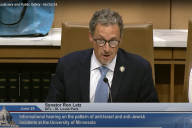You have /5 articles left.
Sign up for a free account or log in.
NEW YORK -- Higher education systems are easy targets. Flagships say that they don't get enough autonomy in them. Regional publics say the flagships get all the money and attention. Frugal lawmakers denigrate systems as offices full of bureaucrats. Legislators constantly think of ways to redesign them.
But systems are important. Jason Lane, director of education studies at the Nelson A. Rockefeller Institute of Government, noted at the opening session of a conference on higher education systems that three-fourths of students at public four-year colleges and universities are enrolled in a system. And system leaders are often the key point of connection between campuses and state governments. With that in mind, the State University of New York (a 64-campus system) organized this conference, "Harnessing Systemness: Delivering Performance."
Nancy Zimpher, chancellor of SUNY, acknowledged that "systemness" -- a word that she uses a lot -- is not in the dictionary. She described the role of systems in identifying state needs and meeting them, involving campuses by looking more broadly than any single campus. Tasks such as reviving state economies and improving state elementary and secondary school systems, she said, require systems, not just efforts by campuses.
While most of the speakers here were in the "pro-system camp," there were many comments about how systems may have not met their potential, or may be dealing with issues for which they weren't designed. Several people mentioned, for example, that systems were generally set up in expansive periods of higher education (post-World War II to the '60s, for many systems), a time when many state leaders were trying to manage growth in an orderly way. These days, systems are heavily involved in allocating cuts or scaling back the ambitions of some programs. And at the same time, many states have turned to systems for help with goals for improving completion rates -- and those efforts can involve asking lots of tough questions of campuses.
Molly Corbett Broad, president of the American Council on Education, said she views discussion of systems' roles as "increasingly important" in times of heightened demands on (and tighter budgets for) higher education. She reflected on her experience leading the University of North Carolina system, and its successful effort to win voter approval for a $3 billion bond proposal for much-needed facilities. The measure passed, comfortably. "No single campus could have achieved that, even Chapel Hill," she said. "It was collective strength."
Further, she said that systems are needed to avoid "mission creep" in which some programs or campuses may expand beyond what the state needs or can afford. Effective systems, she said, "can balance against the unbounded aspirations of the faculty." While such aspirations are appropriate, Broad said, states need to consider their own priorities as well.
Gary Rhoades, professor of education at the University of Arizona and former general secretary of the American Association of University Professors, said that the incentives in higher education today lead universities to focus on their research missions and on becoming more competitive in admissions, while states need higher education to focus on expanding access and reaching students from minority and low-income families. To enthusiastic applause, Rhoades said that systems can -- and should -- push universities on such issues.
Many here acknowledged the tensions between flagship and non-flagship institutions, and between all kinds of institutions and systems. Zimpher noted that before becoming chancellor of SUNY, she led two institutions (the University of Cincinnati and the University of Wisconsin at Milwaukee) that are the second doctoral institutions in their states. So she said she knows what it's like to assume that the flagship has all the advantages. Jane Wellman, executive director of the National Association of System Heads, said that resentment of flagships is hardly new, and has been going on for as long as there have been multiple institutions in states.
Several speakers, however, said that flagships need to stop complaining about their situation and to recognize that part of their role in states is to support systems. Without flagships, many regional colleges and universities on which a state depends are less able to secure support and attention, speakers said.
Patrick M. Callan, of the Higher Education Policy Institute, said that he was "mildly skeptical" of systems. He noted that in California, where he has lived and worked for many years, many people view systems as being "like the Sierra Nevada or the Pacific Ocean, acts of God or nature." But Callan said it was important to remember that systems are political creations, and vary in mission and quality just as states vary in their goals for higher education.
Callan urged attention to what individual systems do or don't do well. For a decade, Callan issued reports that judged state performance on issues such as access, affordability and completion. And he said that, comparing states with and without systems, he couldn't find evidence that having systems "made a difference."
And during the economic downturn of the last four years, Callan said that he has not been impressed with the responses of many systems. "If you look at the way they responded to financial adversity – raising prices and reducing enrollment – it was not innovative, not collaborative,” and hasn't really helped states deal with the situation, Callan said. While many systems have advanced sound policies, he said, “we need to look at the downside too.”








